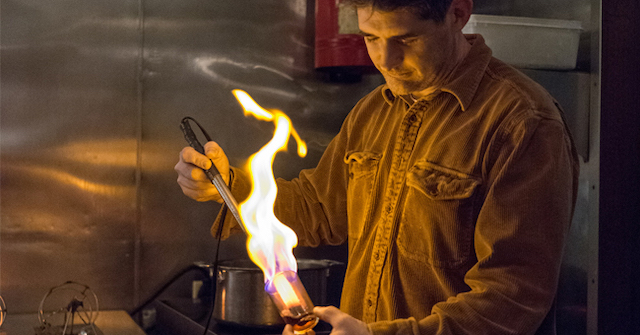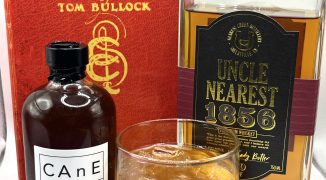From toddies and flips to wassail and spiked coffee, there are almost as many options for hot booze as there are Eskimo words for snow. Many of these recipes are centuries old. But how were they heated?
Nowadays, bartenders have several high and low-tech choices for heating drinks. Most industrial coffee makers have a hot water tap on the side, making hot water easy to come by. If there’s a kitchen available, someone can easily heat liquid in a pan. Or, if you have a fireplace and want to go old-school, you can use a poker.
“Most taverns would have some sort of fireplace,” says Dave Arnold, owner of Booker & Dax and author of “Liquid Intelligence.” “In the fireplace, you’d have irons called loggerheads or flip-dogs. When you ordered your drink, they would mix it, often in the tankard you’d be drinking out of. They’d shove the red-hot poker into the drink, and it would heat right up.”
Unlike other methods of heating, plunging a poker into a drink causes a few cool changes. First, it drastically changes the drink’s flavor profile. “The high temperature from the super hot poker creates a different set of flavors than you would get if you just heated it like you would in a modern day on the stove,” says Arnold. “It burns off some of the sugar and enhances some bitter notes.”
But recreating the colonial method can have a few less-than-pleasant effects. Whenever I [tested drinks] with iron, the results tasted like sucking on a nail,” he says. “They might have been using wrought iron, and that might get seasoned over time. I haven’t had good luck with it.” If you plan to recreate your own tests, do so with caution. Some glasses may shatter.
How, then, did bartenders of yore avoid shattered glass? “I’m not 100 percent sure, but I think that a lot of early drinking vessels would have been made of non-heat-conductive material like pitch-lined leather,” he says. “With those, you wouldn’t have a dangerous drinking condition as a result of doing this.”
These days, pokers look very different. Although a fireplace-based poker service may be possible, they come with a host of safety concerns. At Booker & Dax and several other bars, individual drinks are warmed with a self-heated device. Since this is hotter than any of the pokers available in centuries past, these often also set the drink on fire. “Lighting the drinks on fire reduces the alcohol content somewhat,” says Arnold. “Although there are people who say it doesn’t burn off more alcohol, I don’t believe that. [But] I don’t know that anyone’s actually run the tests to measure it.” Even if you don’t set it on fire, you still get most of the taste benefits, he says.
It also causes a phenomenon known as the Leidenfrost effect. Back in high school chemistry, your teacher probably demonstrated it by quickly dipping a hand into liquid nitrogen. For that split second, the difference in temperature causes a protective vapor barrier to form around the appendage. The same thing happens here. When the poker is put into the liquid, a layer of vapor forms on the surface of the heat source. For a moment, the drink will appear unaffected. Then, it starts bubbling like crazy.
The wider concept of heating a liquid by adding a heat source into it has ancient roots, says Arnold. “Prior to there being vessels that could be put on a fire, people would heat up rocks and heat liquids with them,” says Arnold. “To this day, there are still some cultures that use hot rocks. It’s kind of cool.” Once again, experimenters beware – outside of some soapstones and dolsots, most types of rocks will explode if heated. To decrease your risk for burning your face, remember to remove the stones before drinking.
Bartenders looking to create their own signature hot drinks have a lot of options on how to heat them, says Arnold. But even before they’re heated, several things should be taken into account. Start with a low alcohol content, says Arnold. “You have to have it fairly low because the aroma of hot alcohol will blast your nose off,” says Arnold. “It’s really unpleasant if you get your nose to it.” Even with a low alcohol content, glasses with a narrow mouth can make the ethanol vapors seem more potent. “Don’t try to neck off the glass or serve it in a brandy snifter,” he says. “Go for a wide-mouthed glass.”
Before you start improvising your own recipes, start with the classics. “The hot beer and brandy styles are really fun,” he says. “You can then move to other spirits.” If you’re planning to dilute with beer, go for one with low hops to cut down on the possible bitterness in the final drink. But if you’re opting for water over beer, don’t skimp. According to Arnold, “Remember, you’re not shaking with ice, so all the water you need to add, you have to add.”
As far as other ingredients are concerned, go light on acidic ingredients like citrus. “While you’re testing, I’d probably omit it, then add it back to the heated drink to find a level you like,” he says. “It will taste different if you heat the acid in it.”
After you’ve made all of these decisions, choose how you’re going to heat it. If you want to incorporate the complex flavors created by high heat, you don’t necessarily have to use a poker. “If you’re using a recipe that contains sugar, you can simulate some of the effects of high heat by caramelizing the sugar in a pan before service. Don’t fully burn it,” says Arnold. “Throw your liquor in, and it’ll catch fire. Then you can add beer or water to tone it down. During service, if you want, you can reheat it in a pan normally.” Don’t forget that this process will burn off some of the sugar. “In general, I need to up the sugar content more than I normally would.”
Although serving and exploring hot drinks can sometimes be more challenging than working with their cold counterparts, these concoctions will keep you warm in the winter. “It’s a fun category,” he says.





